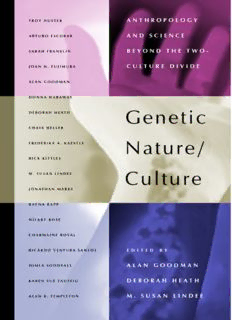
Genetic Nature Culture: Anthropology and Science beyond the Two-Culture Divide PDF
Preview Genetic Nature Culture: Anthropology and Science beyond the Two-Culture Divide
Genetic Nature/Culture Genetic Nature/Culture Anthropology and Science beyond the Two-Culture Divide EDITED BY Alan H. Goodman, Deborah Heath, and M. Susan Lindee UNIVERSITY OF CALIFORNIA PRESS Berkeley Los Angeles London University of California Press Berkeley and Los Angeles, California University of California Press, Ltd. London, England © 2003 by the Regents of the University of California Library of Congress Cataloging-in-Publication Data Genetic nature/culture : anthropology and science beyond the two-culture divide / edited by Alan H. Goodman, Deborah Heath, and M. Susan Lindee. 7 p. cm. Papers presented at a Wenner-Gren Foundation international symposium, held June 11–19, 1999, in Teresópolis, Brazil. Includes bibliographical references and index. ISBN 0–520–23792–7 (alk. paper)—ISBN 0–520–23793–5 (pbk. : alk. paper) 1. Human population genetics—Congresses. 2. Human genetics—Research— Congresses. 3. Human genetics—Moral and ethical aspects—Congresses. 4. Anthropological ethics—Congresses. I. Goodman, Alan H. II. Heath, Deborah, 1952– III. Lindee, M. Susan. GN289 .G455 2003 599.93’5—dc21 2002152222 Manufactured in the United States of America 13 12 11 10 09 08 07 06 05 04 10 9 8 7 6 5 4 3 2 1 The paper used in this publication is both acid-free and totally chlorine-free (TCF). It meets the minimum requirements of ANSI/NISO Z39.48–1992 (R 1997) (Permanence of Paper). contents list of illustrations / vii foreword Sydel Silverman / ix preface and acknowledgments / xv introduction. Anthropology in an Age of Genetics: Practice, Discourse, and Critique M. Susan Lindee, Alan Goodman, and Deborah Heath / 1 part i. nature/culture Section A. Human Populations/Genetic Resources 1. Indigenous Peoples, Changing Social and Political Landscapes, and Human Genetics in Amazonia Ricardo Ventura Santos / 23 2. Provenance and the Pedigree: Victor McKusick’s Fieldwork with the Old Order Amish M. Susan Lindee / 41 3. Flexible Eugenics: Technologies of the Self in the Age of Genetics Karen-Sue Taussig, Rayna Rapp, and Deborah Heath / 58 4. The Commodification of Virtual Reality: The Icelandic Health Sector Database Hilary Rose / 77 Section B. Animal Species/Genetic Resources 5. Kinship, Genes, and Cloning: Life after Dolly Sarah Franklin / 95 vi contents 6. For the Love of a Good Dog: Webs of Action in the World of Dog Genetics Donna Haraway / 111 7. 98% Chimpanzee and 35% Daffodil: The Human Genome in Evolutionary and Cultural Context Jonathan Marks / 132 part ii. culture/nature Section A. Political and Cultural Identity 8. From Pure Genes to GMOs: Transnationalized Gene Landscapes in the Biodiversity and Transgenic Food Networks Chaia Heller and Arturo Escobar / 155 9. Future Imaginaries: Genome Scientists as Sociocultural Entrepreneurs Joan H. Fujimura / 176 10. Reflections and Prospects for Anthropological Genetics in South Africa Himla Soodyall / 200 Section B. Race and Human Variation 11. The Genetics of African Americans: Implications for Disease Gene Mapping and Identity Rick Kittles and Charmaine Royal / 219 12. Human Races in the Context of Recent Human Evolution: A Molecular Genetic Perspective Alan R. Templeton / 234 13. Buried Alive: The Concept of Race in Science Troy Duster / 258 14. The Good, the Bad, and the Ugly: Promise and Problems of Ancient DNA for Anthropology Frederika A. Kaestle / 278 list of contributors / 297 index / 299 illustrations FIGURES 2.1. The “Amish Madonna” / 47 2.2. A polydactylous dwarf / 52 7.1. Molecular homology / 142 7.2. Some diagnostic differences between human chromosomes / 144 7.3. Ape, fish, human comparison / 147 12.1. Models of recent human evolution / 240 12.2. Portrayals of human genetic distances / 243 12.3. Genetic distance and isolation by geographic distance / 245 TABLES 13.1. Selected high incidence of genetic disorders / 268 13.2. Ethnicities or groups primarily affected by disorders (U.S.) / 268 13.3. Ethnic or group variation with incidence of cystic fibrosis / 270 14.1. Anthropological applications of ancient DNA techniques / 280 vii foreword Sydel Silverman In the last decade of the twentieth century, anthropology, like many other disciplines, was deeply affected by the revolution in genetic science. Both as a set of methodological tools and as an object of study in its own right, genet- ics assumed an increasingly important place in anthropological research and practice, presenting new opportunities and new challenges. At the same time, public discourse around genetics intensified, touching on long-held concerns of anthropologists; yet the anthropological voice was not often heard, even when it was sorely needed. This confluence of developments led to the idea for a conference on anthropology and the new genetics. It came to fruition as a Wenner-Gren Foundation’s international symposium, “Anthropology in the Age of Genetics: Practice, Discourse, Critique,” which took place in June 1999, in Teresópolis, Brazil. This volume is a product of that conference. I had become aware of the reverberations of the new genetics in anthro- pology primarily from reading the nearly one thousand grant proposals sub- mitted to Wenner-Gren each year. This perspective afforded a significant— albeit only partial—window on the discipline. From this window I could see enormous potential for research in all areas of anthropology but also some danger signs. For each of the subfields, the developments in genetics opened up new problems for study and new approaches to old problems, but they also brought new difficulties. The anthropological study of living nonhuman primates was profoundly affected by the advent of new genetic methods. For some time in this field, the predominant goal had been to identify the evolutionary significance of behaviors and social patterns. A key question, of course, was whether genes actually did get replicated in accordance with the predictions; but until recently, this question could be addressed only by inference. The invention ix
Description: